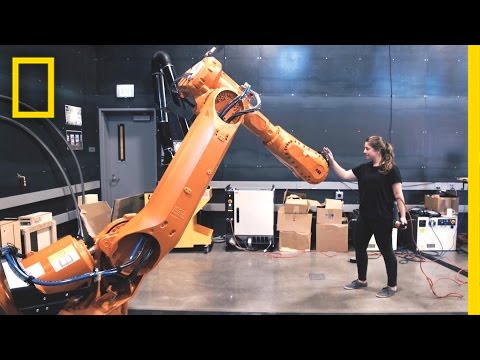Industrial Robots: Redefining the Boundaries of Artistry
The art world has always been a hub of creativity, innovation, and boundary-pushing. Throughout history, artists have used various mediums and technologies to express their ideas and challenge conventional norms. In recent years, the emergence of industrial robots has opened up a whole new realm of artistic possibilities. One artist, Madeline Gannon, has taken the art world by storm with her groundbreaking gesture-based software, Quipt, which allows her to tame and manipulate these powerful machines with her movements.
In an awe-inspiring short film titled “Meet Madeline, the Robot Tamer,” Madeline Gannon demonstrates the remarkable capabilities of her creation. As an artist-in-residence at Pier 9, she seamlessly blends the worlds of art and technology, showcasing the transformative potential of industrial robots in the creative realm. Her mesmerizing choreography with these machines is a testament to the harmonious union of technology and artistic expression.
Gannon’s Quipt software allows her to communicate with industrial robots through intuitive gestures, transforming her body into a conduit of creativity. By seamlessly linking her movements to the robots’ actions, she is able to command them with grace and precision. This symbiotic relationship between human and machine blurs the line between artist and inventor, reminding us of the limitless possibilities that lie at the intersection of art and technology.
The industrial robots themselves are marvels of engineering. These powerful machines, with their immense strength and precision, were once confined to factory floors, performing repetitive tasks in manufacturing processes. However, Gannon’s work highlights a new frontier for these robots, where their potential as artistic tools is unleashed. By harnessing their capabilities and combining them with her creative vision, she challenges our perceptions of what art can be.
One cannot help but marvel at the intricate dance between Gannon and the robots. As she moves with purpose and grace, the machines respond in kind, their movements mirroring her every gesture. This mesmerizing choreography captivates the viewer, inviting us to contemplate the nature of creativity, human-machine collaboration, and the evolving role of technology in the arts.
Gannon’s demonstration not only showcases the seamless integration of art and technology but also raises intriguing questions about the future of artistry. As industrial robots become increasingly sophisticated, will artists be able to fully exploit their potential? Will we see a new generation of robotic artists emerge, creating masterpieces that challenge and inspire us? Only time will tell, but one thing is certain: the fusion of art and industrial robotics holds immense promise.
The implications of Gannon’s work extend beyond the art world. The collaboration between humans and machines has the potential to revolutionize various industries, from manufacturing and construction to healthcare and entertainment. By pushing the boundaries of what is possible, Gannon and her gesture-based software Quipt pave the way for a future where human creativity and robotic precision seamlessly coexist.
The journey of exploration and experimentation that Gannon embarks upon is an inspiration to artists and innovators alike. She fearlessly embraces the unknown, charting a path towards a future where art and technology converge. Her work serves as a reminder that the blending of disciplines and the intersection of ideas can lead to groundbreaking discoveries and create new avenues for human expression.
In conclusion, industrial robots, once confined to the monotonous tasks of assembly lines, are now finding a new purpose in the art world. Madeline Gannon, through her gesture-based software Quipt, has demonstrated the transformative potential of these machines in the realm of artistic expression. Her captivating choreography with these powerful robots challenges our perceptions of what is considered art and inspires us to reimagine the possibilities of human-machine collaboration. As we stand at the precipice of a technological revolution, it is artists like Gannon who remind us of the vital role that creativity and imagination play in shaping our future.
Industrial Robot
“Unveiling the Robot Tamer: A Riveting Journey in Madeline’s World of Industrial Robots”


